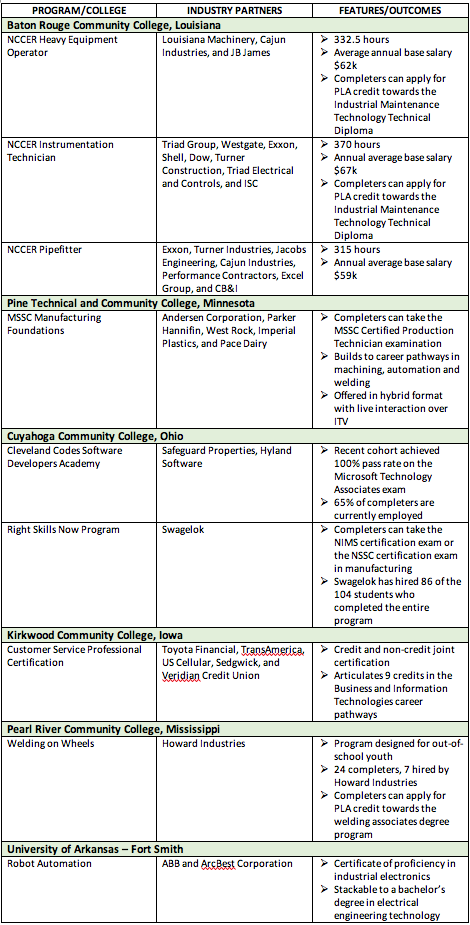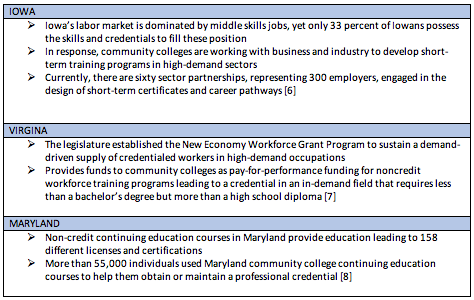Published on
With the Growth in the Number of Short-Term Credential Programs, Why is Stackability and Employer Engagement Critical?

In today’s economy, 80 percent of all jobs require some form of a credential beyond high school. Concomitantly, 45 percent of small businesses in America are unable to find qualified job applicants to fill job openings, particularly those “middle skill” jobs that require specific technical skills [1]. These middle skills are acquired through either an industry-based certification program or a shorter-term certificate program designed in partnership with business and industry. Accordingly, the demand for middle skills is strong. In 2015, the Bureau of Labor Statistics estimated that 53 percent of the US labor market was middle skill jobs yet only 43 percent of the country’s workers possessed the requisite skills. Additionally, the demand for middle skills jobs is expected to remain strong through to 2024 with middle skills jobs comprising 48 percent of all job openings [2].
Thus, credentials (short-term certificates and industry-based certifications) are increasingly important for individuals who want to advance in the workplace and achieve greater economic mobility. The attainment of a credential demonstrates the mastery of the knowledge, skills and abilities desired by employers putting learners on a path towards gainful employment. One recent study shows that certificate holders earn 30 percent more than individuals with a high school diploma alone and the wage premium for short-term programs is often comparable or higher than associates degrees and even bachelor’s degrees in certain fields [3].
Since the early 2000s, community colleges have been stacking certificates to create career pathways. The short-term credentials embedded into career pathways make up 24 percent of all postsecondary awards in the US today [4]. In the 2014-15 academic year, more than 600,000 short-term credentials were conferred at public institutions—a 63 percent increase from the 370,000 credentials granted during the 2004-05 academic year [5]. Certificates have become so popular that they are now the second most common higher education credential in the United States, signaling that students and employers are recognizing the value of short-term credentials at an increasing rate.
Nonetheless, short-term credentials only have value if they are a) designed to respond to local labor market needs, and b) designed to ensure long-term success through continuing learning opportunities. A certificate or certification program that has not been developed utilizing labor market data and employer engagement in design leaves students with a credential that has little or no meaning in the local economy. Consequently, certificate programs must be thoughtfully designed if they are to improve a student’s employment opportunities.
Labor markets are not static. Rapidly changing technologies are compelling workers to return to school and upgrade their skills just to retain their current jobs. At the same time, futurists predict that automation and artificial intelligence (AI) will impact work in such a way that many or most American workers will have to repeatedly retool themselves for new work over their careers. Thus, certificate programs or certifications must be part of a stackable career pathway. Stackable programming allows individuals to pair learning and career progression, instead of approaching them as sequential activities.
More importantly, whether a credential is offered through non-credit programming or credit programming, it is incumbent upon educators to ensure that these short-term credentials articulate into longer-term training opportunities. Carnevale et al found that short-term credentials and certifications serve as the first rung on the ladder to a college degree; two out of every three workers who have a certificate and a college degree earned the certificate first—an indication that certificates can serve as a stepping stone to a college degree.
Colleges Examples
Below are several examples of short-term certificate programs offered by community colleges. Industry partners are identified along with the opportunity for completers to engage in longer-term learning.
Three State Examples
Below are examples of three state efforts to increase the certificates and certifications offered by community colleges highlighting the importance of business and industry partnerships.
The reality is that in today’s labor market, some level of postsecondary education or training has increasingly become a prerequisite for both economic security and continued professional development. While numerous studies have shown that not all certifications or short-term certificate programs are equal, the data does show that short-term credentials can play an important role in preparing learners with the requisite competencies needed for on-the-job success while ensuring the opportunity for continuous skill upgrade. Additionally, when there is employer engagement in designing programs that are aligned with employer demands, employer confidence in the efficacy of the short-term credentials is improved which in turns improves the ability of the certificate holder to achieve economic success. Finally, when the short-term credential is embedded in a career pathway, workers possess the ability to reconnect to the postsecondary system to upskill and retain currency as the labor market evolves.
———-
References
[2] NSC analysis of Bureau of Labor Statistics Occupational Employment, Statistics by State, May 2015 and American Community Survey data, 2015.
[4] Certificates: Gateway to Gainful Employment and College Degrees, Anthony P. Carnevale, Stephen J. Rose, and Andrew R. Hanson, Georgetown University Center on Education and the Workforce, June 2012. https://cew.georgetown.edu/cew-reports/certificates/
[5] https://nces.ed.gov/programs/coe/indicator_cts.asp
[6] https://www.educateiowa.gov/iowa-community-college-program-outcomes
[7] https://lis.virginia.gov/cgi-bin/legp604.exe?161+sum+HB66
[8] https://mdacc.org/wp-content/uploads/MCCACET-Report-LicCert_FINAL_FY16.pdf
Author Perspective: Association





